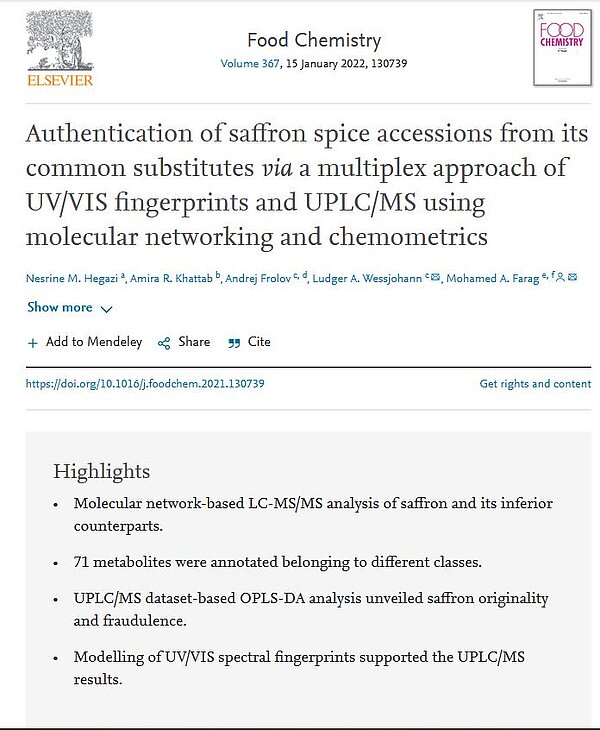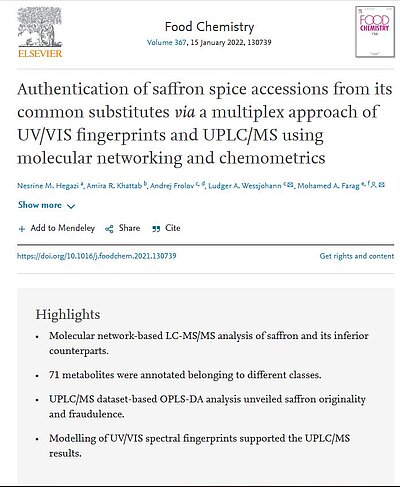Smart against fraud: Saffron substitutes unmasked.
Because of its unique taste, its health-promoting properties and its laborious extraction, saffron is the most expensive spice of all time. As early as the Middle Ages, the coveted crocus stigmas were traded at three times the price of pepper. By 2025, its market value is estimated at $730 million. Fraudulent substitution of saffron threads with stigmas of maize, marigolds and safflower are as old as the spice trade itself. It fuels a continuing development of appropriate detection methods for these impurities. IPB scientists, together with partners from Cairo University and Arab Academy for Science, Technology & Maritime Transport, have now developed a method that can detect these substitutes better than conventional analytical methods.
For this purpose, they used a molecular network as a visualization tool for UPLC/MS datasets of saffron and its most common substitutes from safflower and marigold. Based on this Global Natural Products Social Molecular Networking Platform, they were able to identify distinct signals such as the abundance of certain chalcone and flavanone glycosides for the presence of safflower or cinnamic acid esters for marigold. In contrast, unadulterated saffron samples showed a consistent pattern of flavonol O-glycosides, such as kaempferol-O-sophorosides and crocetin esters. In addition, the Halle scientists could identify the UV/VIS fingerprint spectral regions of the colored picrocrocin and crocin derivatives as a specific feature of true saffron, which could replace the effortful purity determination via UPLC/MS in the future.
The identification of different saffron varieties was also successful: using untargeted UPLC-coupled high-resolution mass spectrometry, the scientists established a metabolite profiling of the non-volatile saffron substances and, again with the aid of the molecular network, they could define robust distinguishing features between saffron samples of different geographical origin. This served primarily to differentiate Iranian saffron from Spanish saffron varieties that are considered to be of higher quality.
Saffron is obtained from the dried stigmas of Crocus sativus and harvested by hand. In folk medicine, the spice is used to treat depression and insomnia, as well as digestive and cardiovascular problems. Recent studies also indicate antioxidant, antitumor and antibacterial effects of saffron. The predominant colorants are crocines, while the monoterpenaldehyde safranal is responsible for the distinctive flavor of the yellow flower parts. The economic value of the spice depends largely on its origin. The main producer is Iran with a market share of over 90%. In addition, there are smaller growing areas in Afghanistan, Azerbaijan, China, Italy, India, Greece, Morocco and Spain. The quality of saffron is evaluated with international ISO standard based on spectrophotometric and chromatographic determination of picrocrocin, safranal and crocines. However, the ISO protocol is not accurate enough: adulterations with safflower, marigold and curcuma of up to 20% cannot be detected with the certified ISO method.
Original Publication:
Nesrine M. Hegazi, Amira R. Khattab, Andrej Frolov, Ludger Wessjohann & Mohamed Farag. Authentication of saffron spice accessions from its common substitutes via a multiplex approach of UV/VIS fingerprints and UPLC/MS using molecular networking and chemometrics. Journal of Food Chemistry 2021, 367:130739, doi: 10.1016/j.foodchem.2021.130739.



